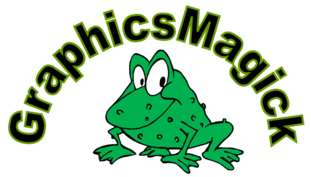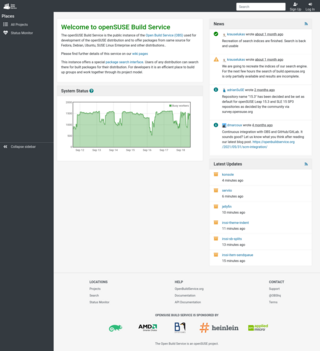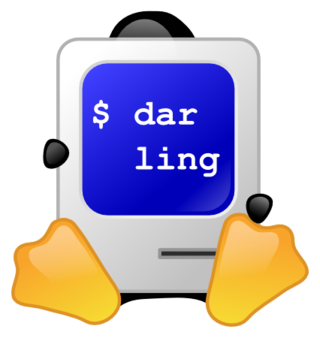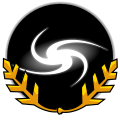Helix DNA was a project to produce computer software that can play audio and video media in various formats and aid in creating such media. It is intended as a largely free and open-source digital media framework that runs on numerous operating systems and processors and it was started by RealNetworks, which contributed much of the code. The Helix Community was an open collaborative effort to develop and extend the Helix DNA platform. The Helix Project has been discontinued.
CodeWeavers is a software company that focuses on Wine development and sells a proprietary version of Wine called CrossOver for running Windows applications on macOS, ChromeOS and Linux. The company was founded in 1996 as a consultancy, eventually moving entirely over to Wine development and support.

GraphicsMagick is a fork of ImageMagick, emphasizing stability of both programming API and command-line options. It was branched off ImageMagick's version 5.5.2 in 2002 after irreconcilable differences emerged in the developers' group.

The Google Summer of Code, often abbreviated to GSoC, is an international annual program in which Google awards stipends to contributors who successfully complete a free and open-source software coding project during the summer. As of 2022, the program is open to anyone aged 18 or over, no longer just students and recent graduates. It was first held from May to August 2005. Participants get paid to write software, with the amount of their stipend depending on the purchasing power parity of the country where they are located. Project ideas are listed by host organizations involved in open-source software development, though students can also propose their own project ideas.

The Spring Engine is a game engine for real-time strategy (RTS) video games. The game engine is free and open-source software, subject to the terms of the GNU General Public License v2.0 or later.

Google Web Toolkit, or GWT Web Toolkit, is an open-source set of tools that allows web developers to create and maintain JavaScript front-end applications in Java. It is licensed under Apache License 2.0.

Pitivi is a free and open-source non-linear video editor for Linux, developed by various contributors from free software community and the GNOME project, with support also available from Collabora. Pitivi is designed to be the default video editing software for the GNOME desktop environment. It is licensed under the terms of the GNU Lesser General Public License.

Black Duck Open Hub, formerly Ohloh, is a website which provides a web services suite and online community platform that aims to index the open-source software development community. It was founded by former Microsoft managers Jason Allen and Scott Collison in 2004 and joined by the developer Robin Luckey. As of 15 January 2016, the site lists 669,601 open-source projects, 681,345 source control repositories, 3,848,524 contributors and 31,688,426,179 lines of code.

Linux is a family of open-source Unix-like operating systems based on the Linux kernel, an operating system kernel first released on September 17, 1991, by Linus Torvalds. Linux is typically packaged as a Linux distribution (distro), which includes the kernel and supporting system software and libraries, many of which are provided by the GNU Project. Many Linux distributions use the word "Linux" in their name, but the Free Software Foundation uses and recommends the name "GNU/Linux" to emphasize the use and importance of GNU software in many distributions, causing some controversy.

The Linux Foundation (LF) is a non-profit organization established in 2000 to support Linux development and open-source software projects. In addition to providing a neutral home where Linux kernel development can be protected and accelerated, the LF is dedicated to building sustainable ecosystems around open-source projects to accelerate technology development and commercial adoption.
Comparison of the Java and .NET platforms.

MonoDevelop was an open-source integrated development environment for Linux, macOS, and Windows. Its primary focus is development of projects that use Mono and .NET Framework. MonoDevelop integrates features similar to those of NetBeans and Microsoft Visual Studio, such as automatic code completion, source control, a graphical user interface (GUI) and Web designer. MonoDevelop integrates a Gtk# GUI designer called Stetic. It supports Boo, C, C++, C#, CIL, D, F#, Java, Oxygene, Vala, JavaScript, TypeScript and Visual Basic.NET. Although there is no word from the developers that is has been discontinued, nonetheless it hasn't been updated in 4 years and is no longer installable on major operating systems, such as Ubuntu 22.04 and above. Its parent Microsoft, seems to have shifted focus to Visual Studio Code and the .NET Framework, which runs on many operating systems, including Linux.
Betavine was an open community and resource website, created and managed by Vodafone Group R&D, for the mobile development community in order to support and stimulate the development of new applications for mobile and Internet communications. The Betavine website allows developers to upload and profile their alpha-stage and beta-stage applications, provides interaction tools for members to share knowledge and give feedback on apps, and discuss topics in mobile. Betavine also contains a growing resources section with technical topics and APIs.

The Open Build Service is an open and complete distribution development platform designed to encourage developers to compile packages for multiple Linux distributions including SUSE Linux Enterprise Server, openSUSE, Red Hat Enterprise Linux, Mandriva, Ubuntu, Fedora, Debian, and Arch Linux. It typically simplifies the packaging process, so developers can more easily package a single program for many distributions, and many openSUSE releases, making more packages available to users regardless of what distribution they use. Also, product and appliance building is supported by OBS.

Mono is a free and open-source .NET Framework-compatible software framework. Originally by Ximian, it was later acquired by Novell, and is now being led by Xamarin, a subsidiary of Microsoft and the .NET Foundation. Mono can be run on many software systems.

Trojitá is a free software IMAP and SMTP email client developed using the Qt C++ library. The design goals of the maintainers are to develop a fast e-mail client which respects open standards, is cross-platform and uses the available resources very efficiently.
libGDX is a free and open-source game-development application framework written in the Java programming language with some C and C++ components for performance dependent code. It allows for the development of desktop and mobile games by using the same code base. It is cross-platform, supporting Windows, Linux, Mac OS X, Android, iOS, BlackBerry and web browsers with WebGL support.

Darling is a free and open-source macOS compatibility layer for Linux. It duplicates functions of macOS by providing alternative implementations of the libraries and frameworks that macOS programs call. This method of duplication differs from other methods that might also be considered emulation, where macOS programs run in a virtual machine. Darling has been called the counterpart to WINE for running macOS apps.
Microsoft, a technology company historically known for its opposition to the open source software paradigm, turned to embrace the approach in the 2010s. From the 1970s through 2000s under CEOs Bill Gates and Steve Ballmer, Microsoft viewed the community creation and sharing of communal code, later to be known as free and open source software, as a threat to its business, and both executives spoke negatively against it. In the 2010s, as the industry turned towards cloud, embedded, and mobile computing—technologies powered by open source advances—CEO Satya Nadella led Microsoft towards open source adoption although Microsoft's traditional Windows business continued to grow throughout this period generating revenues of 26.8 billion in the third quarter of 2018, while Microsoft's Azure cloud revenues nearly doubled.
The Cloud Native Computing Foundation (CNCF) is a Linux Foundation project that was founded in 2015 to help advance container technology and align the tech industry around its evolution.













